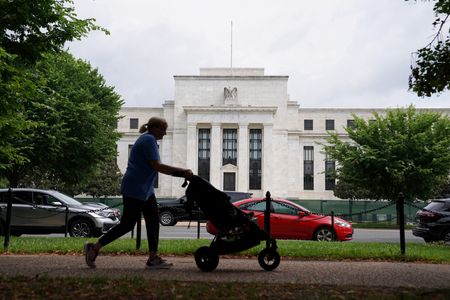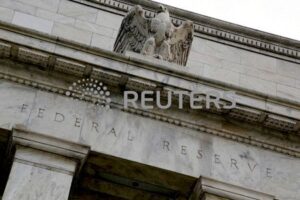By Howard Schneider and Michael S. Derby
UPPER MARLBORO, Maryland (Reuters) -Top Federal Reserve officials said on Wednesday the U.S. central bank is “closer” to cutting interest rates given inflation’s improved trajectory and a labor market in better balance, remarks that set the stage for a first reduction in borrowing costs in September.
Fed Governor Christopher Waller and New York Fed President John Williams both noted the shortening horizon toward looser monetary policy, with Waller highlighting it in a speech at the Kansas City Fed and Williams voicing it in a Wall Street Journal interview.
Separately, Richmond Fed President Thomas Barkin said he is “very encouraged” that declines in inflation had begun to broaden. “I’d like to see that continue,” he told a business group in Maryland.
The remarks are the latest in a rush this week of commentary from top U.S. central bank officials – including Fed Chair Jerome Powell – to note their increased confidence that the disinflationary trend that began last year is continuing, despite a short-lived bump in inflation earlier this year.
Price pressures appear to be easing across the board, the Fed officials said, with goods prices falling, housing cost increases slowing, and more moderate wage growth feeding into a long-awaited easing of price increases in the services sector.
Williams and Waller appeared to rule out a rate cut at the Fed’s July 30-31 policy meeting, a view reflected in financial markets that are now pricing the probability of a move at that meeting at less than 5%.
Waller listed September through December as the potential time frame when conditions for a rate cut could be right, omitting July.
In his WSJ interview, Williams said, “We’re actually going to learn a lot between July and September. We’ll get two months of inflation data.”
All three policymakers who spoke on Wednesday were “pointing to September” for a start to the policy easing, Karim Basta, chief economist at III Capital Management, wrote.
Financial markets agree, and on Wednesday kept bets the U.S. central bank, which has held its policy rate in the 5.25%-5.50% range for the past year, will cut borrowing costs again in November and December, bringing the benchmark policy rate to the 4.50%-4.75% range by the end of 2024.
Waller, who in May had said he would need several more months of improved inflation data to convince him that rate cuts would be warranted, said data last week showing the first monthly drop in the consumer price index in four years “was the second month of very good news.”
He laid out what he saw as three scenarios for how inflation may play out in the months ahead. The two most likely of those, Waller said, suggest inflation will continue to moderate toward the Fed’s 2% target in the months ahead, albeit in one scenario more rapidly and consistently than the other. The third and least likely possibility was for inflation to reaccelerate and keep rate cuts on hold.
Still, Waller said, “given that I believe the first two scenarios have the highest probability of occurring, I believe the time to lower the policy rate is drawing closer.”
Williams, who is also vice chair of the central bank’s rate-setting Federal Open Market Committee, said: “I feel like the past three months – and I would include in June, based on what we’ve seen – seems to be getting us closer to a disinflationary trend that we’re looking for. I would like to see more data to gain further confidence inflation is moving sustainably towards our 2% goal. We’ve got a few good months now.”
‘SOFT LANDING’
More Fed policymakers have suggested they are getting increasingly comfortable that the pace of price increases is more firmly on track back down to 2%, after higher-than-expected readings earlier in the year.
While inflation has eased notably from its high-water mark two years ago, progress has been lumpy with uneven contributions from important categories.
On Tuesday, though, Fed Governor Adriana Kugler said she saw goods, services and now housing contributing to easing price pressures.
“We’re seeing more progress on all three categories now,” Kugler told a National Association for Business Economics seminar. “I’m cautiously optimistic that we’re seeing progress and the type of progress that we need to get back to 2%.”
By the Fed’s preferred measure, inflation in May was running at a 2.6% annual rate, down from the 7.1% peak reached during the COVID-19 pandemic. The data for June is due on July 26.
Fed chief Powell on Monday also said that inflation readings over the second quarter of this year “add somewhat to confidence” on its downward path, suggesting a start of an easing cycle may not be far off.
The U.S. central bank “may well be able to achieve the soft landing” of bringing down inflation without triggering a painful recession and sharp rise in unemployment, Waller said on Wednesday.
But noting that the unemployment rate rose to 4.1% in June, Waller added, “there is more upside risk to unemployment than we have seen for a long time.”
(With reporting by Harshita Meenaktshi and Lindsay Dunsmuir; Writing by Dan Burns and Ann Saphir; Editing by Andrew Heavens, Tomasz Janowski, Andrea Ricci and Paul Simao)





